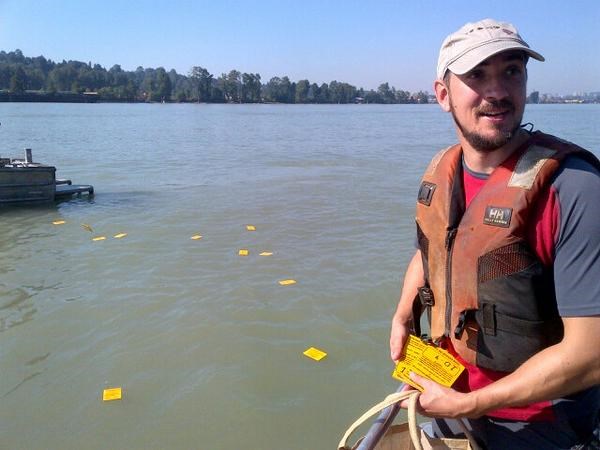If you've walked along the dyke recently, you might be asking yourself: What are those yellow things floating in the Fraser River or stuck on the rocks?
Well, they're biodegradable wooden cards, tossed overboard by environmentalists from the Georgia Strait Alliance and Raincoast Conservation Foundation on Tuesday to simulate the rapid dispersion of oil in the event of a failure from Kinder Morgan's Trans Mountain pipeline, which crosses the river near the Port Mann Bridge.
This was the fourth round of card experiments — which began in October — and the first time the groups dropped cards in the river. They also dropped cards in eight other locations related to pipeline or shipping routes in nearby waters.
The two groups, in concert with the City of Vancouver, have been applying this experiment to protest the planned twinning of the existing pipeline that will see up to a seven-fold increase in tanker traffic in Burrard Inlet.
"Because of what we've learned about our oil spill capacity in the region, if there were a major spill today we don't have the equipment in place or people to respond in any effective way," said Christianne Wilhelmson, an organizer with the Georgia Strait Alliance.
Last year the environmentalists released 2,500 cards along the shipping route from Vancouver to the Juan de Fuca Strait. Over 1,000 cards have since been reported from Washington state all the way to Haida Gwaii. Most of the cards washed ashore nearby and within three days.
The results are being used to improve scientist's understanding of ocean circulation in the Salish Sea. One of the reasons the groups dropped more cards this month is because ocean patterns vary from season to season.
“We know that oil can move on the river or ocean surface for weeks or months. Drift cards give us a broader picture of where and when oil could appear in the long term,” said Raincoast marine biologist Andy Rosenberger.
The groups claim their efforts to obtain simulation data through information requests to the National Energy Board have been unsuccessful.
Wilhelmson admitted the experiment was solely focused on Kinder Morgan and did not address the planned VAFFC jet fuel terminal, to be built next to the Riverport Entertainment Complex.
"But certainly, we're trying to find data that's relevant to other kinds of spills," she said, while noting jet fuel acts in a different way than oil and that she's uncertain if the wooden card experiment could be as accurate as it is for oil.
She said the river faces a critical environmental juncture.
"There's also coal and LNG, and all these projects that are creating more issues…being brought to the fore."
Wilhelmson said the growth in fuel transportation along the river is even more worrisome in the absence of a lack of a robust oil spill plan.
If you see a card, you're being asked to collect it and call the number on it so the groups can track the end location, or rather, where the oil ends up. A website will track the card locations in a colour coordinated manner.
To report a card, call 1-877-655-1229. To see the results of the study, visit www.SalishSeaSpillMap.org.



